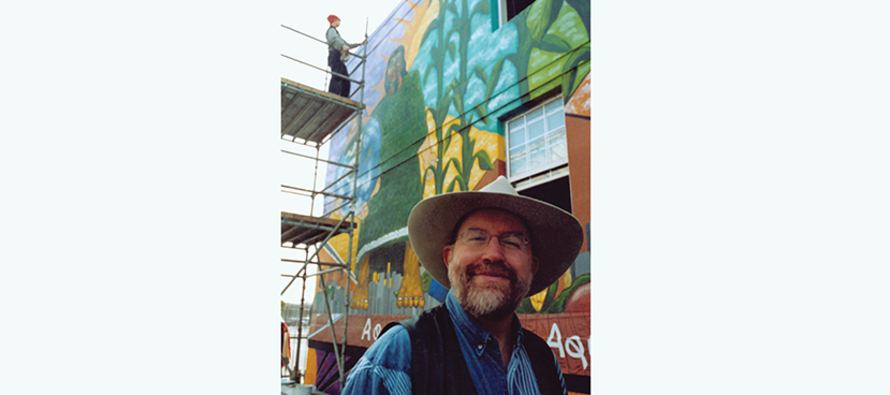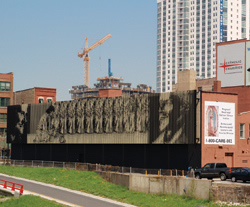Brother Mark Elder makes an art of spirituality

Image: MARK ELDER in front of the Pilsen Neighbors Community Council mural in Chicago.
WHEN MARK ELDER, a Vincentian brother, is asked why he became a brother instead of a priest, he likes to reply, “I didn’t want to work on Sundays."
“It’s a joke, of course," he says with a grin. “But there’s a small bit of truth to that."
As a child, Mark Elder had familiar boyhood dreams of what he wanted to be. A professional baseball player, perhaps. Certainly, a Marine fighter pilot like his dad. But life takes its own turns, and Mark Elder is not only a member of the Congregation of the Mission (the Vincentians) but a highly respected instructor of art, university public art coordinator at Chicago’s DePaul University, and creator of some of the most striking murals in the United States and elsewhere.
In fact, Elder’s students at DePaul often ask him to explain the difference between being a brother and a priest. “I try to pin it down the best I can," he says. “I tell them that, traditionally, brothers were mostly monastic, and they would ordain a few of them as priests to serve their needs [for Mass and the sacraments]. But the Vincentians are different. They’re a religious group that’s mainly a group of priests—and then there are a few knuckleheads like me. But basically we all strive to do various works for the evangelization of the poor and disenfranchised as best we can.
“I liked the idea of religious life, but there were some things about the priesthood that wouldn’t be too conducive for me. So I’d rather stay as a brother, do the work, and let it go at that. I can’t really put my finger on any one thing. I knew I’d have a hard time studying theology. I didn’t know if I could really hold on to enough discipline to learn it properly."
| BROTHER MARK ELDER’S MURAL, "The Mandatum," is seen by tens of thousands daily from Chicago's Kennedy Expressway. |
"All the faces are based on drawings I made, so there’s a series of 16 faces repeated throughout," he explains. “I did it with a German masonry paint, mineral silicate, which is very durable and should last 70 years. The university commissioned the mural. I had come up with the idea as part of our centennial celebration. People will see the faces and say, ‘Yeah, I know that guy,’ or, ‘How come I’m not on there?"
Another huge Elder work, “The Mandatum" (2003), is a “shadow mural"—152 feet-by-22 feet—on a wall of the Catholic Charities building on Randolph Street in downtown Chicago just off the Kennedy Expressway. The full effect of the piece depends on from what angle one is looking.
Elder learned about the technique during a stay in Rome. “It was an epiphany for me. I felt the providence of God came down upon me and said, ‘Look, you have to learn how to do this because this is how you’re going to handle the Catholic Charities building.’ I call it a shadow image technique, and, as far as I know, this is the first time it’s been used in the United States. It’s made of strips of quarter-inch aluminum mounted on steel."
The mural consists of two representations: Vincent DePaul and Frédéric Ozanam, founder of the Society of St. Vincent DePaul. “Here were two geniuses at creating programs for the poor," Elder notes. “When you look at these portraits straight on, you get a pure shadow effect, and it’s very ghostlike. When you move to one side, it becomes more pronounced."
In between is a scene from the Last Supper, where Christ is washing the feet of one of the disciples. “I like to have fun with something like this," Elder says. “You see this figure right over here? Well, there’s my malcontent. Judas? Could be? Could be anybody, really. It could be any of us, because there’s always somebody in the crowd who’s not too happy for whatever reason.
“It was not cheap to put up. It took quite an effort, and we had to get sizable donations from foundations and individuals. The aluminum alone was $100,000. The great thing was I never really had to twist anybody’s arm. All I had to do was show these two guys here, and people would become fascinated. My pièce de résistance? Yeah, right now it is."
“Brother Mark is down-to-earth, laid-back, and certainly something of a character," adds Father Christopher Robinson, an assistant professor of religious studies at DePaul. “And he clearly is Vincentian in that the theme of much of his art relates to charity and a concern for the poor. Students enjoy his classes, particularly one I met who painted a mural on the side of a school in a rough part of town."
Elder, 51, draws a close connection between his vocation and his work as an artist. “When I see what my work is doing, especially when I work with a group on a mural, the art somehow promotes all the values that I believe in. And by making the art more or less democratic, the people take ownership. For example, there’s “Spirit of Sacred Heart," an acrylic-on-concrete mural at Sacred Heart Catholic School in Patterson, California. We had not only all the kids from the school working on it, but some of the parents. You know, it’s just as much their mural as it is mine. And there’s a source of pride in that, a means of empowerment. And by doing that, in a way, you can evangelize through that. Same thing with a mural at the Pilsen Neighbors Community Council Building in Chicago’s Pilsen [largely Mexican American] neighborhood."
Besides all his other talents, Elder does a dead-on impersonation of Harry Caray, the late, legendary, gravelly-voiced baseball announcer for the St. Louis Cardinals and Chicago White Sox and Cubs—which he is more than pleased to demonstrate. (“Hello, everybody, this is Harry Caray speaking to you live from Mark Elder’s living room, where we’re keeping the Budweiser cold, and I’m on tap.") “I spent a lot of years in Missouri," he confides with a smile, “and have always been a Caray fan."
The family moved every three years, living mostly in the southeastern United States. Whenever his father was serving overseas, they’d live in his grandparents’ home in Sainte Genevieve, Missouri, the oldest French settlement west of the Mississippi. Mark attended three high schools, graduating from St. Vincent’s College in Cape Girardeau, Missouri in 1972. “It was called a college, but it was really a high school—a Vincentian seminary," he says. “Mark Twain wrote about it in Life on the Mississippi—even though [laughs] he referred to it as ‘the Jesuit place on the hill.’ It was there that I got my vocation."
Elder’s decision to become a brother didn’t occur because of some sudden epiphany but just evolved. He had heard about the seminary through a cousin, who had gone there. (“When I started, I had no ambition to become a priest or brother.") But after graduation, he decided to explore things a little further by entering a Vincentian novitiate in Santa Barbara, California. “It was a wonderful seminary, up in the hills, very scenic," he remembers. “And, you had no formal studies. So basically you were there, really, to bring your spiritual life together the best you could—at the age of 18 or 19. [Laughter.] We did the best we could, and I just ended up being very attracted to it. I couldn’t think of anything else I’d rather do. So that year was really important."
|
Other Elder works
Mark Elder's artworks also include “The Vincentian Family: The Gleaners," a mural in the lobby of the Vincentian headquarters in Rome, which depicts the five Vincentian virtues: simplicity, humility, meekness, mortification, and zeal. (“Zeal is the only one in full color," he notes with a smile.) |
Elder became a Vincentian simply because he attended a Vincentian seminary. “Their mission is to serve the poor. Vincent DePaul was the great inventor of the concept of organized charity." He went on to the Vincentians’ seminary in Perryville, Missouri. After two years, it was decided that he should go to DePaul to get a degree in physical education so he could teach. After graduating in 1979, he taught at every level from kindergarten to 12th grade in Cape Girardeau, St. Louis, and East St. Louis.
Next, he was asked to run an art-related program at the Vincentians’ St. Thomas Seminary in Denver, where he earned a master of fine arts degree from the University of Denver. From then on, his teaching was devoted to art instead of physical education. For 10 years, he has been teaching at DePaul, where his classes include a basic class for non-art majors.
It was after high school that he realized he liked to teach young people. His passion for art developed later. “All along, I became more and more infatuated by teaching myself how to paint," he recalls. As a young kid, I was interested in art a little bit, but not as much as most artists would be. I would say I was a late bloomer. When I got seriously interested in art, I was about 35."
As for advice for young people considering a vocation to religious life: “I would say just be open, and try to relax and let the Spirit communicate with you as to what God is calling you to do. If it ends up that you should stay with it, at least you have a better conviction knowing that. Vincentians always question why someone comes to us, but it’s better that we question why they stay. That’s the bigger question."
Elder himself seems to have plenty of reasons both for becoming and remaining a brother. “I love to see that I left somebody interested in either wanting to do what I do or happy that I was there with them. You know, the work is fantastic. . . . I honestly don’t know what I’d be doing if I weren’t doing this. I mean it’s a great life."
Tags
Related
- Better together: Profile of Brother David Relstab, O.S.A.
- The secret’s out: Brotherhood is powerful
- Brothers win the race: Profile of Brother Rafael Vargas, S.D.B.
- God called me to be a brother
- Modern “prodigal son” meets the brothers: Profile of Brother Ray Morris, B.H.
- Brotherhood is right for me
- Big Brother is watching you
- Why did I become a brother?
- How God tricked Duc Pham into becoming a brother
- Why I hate Tuesdays and Thursdays Read More
Most Viewed
- Find your spirituality type quiz
- FAQs: Frequently asked questions about vocations
- Celibacy quiz: Can you live a celibate life?
- Resources for older discerners or those with physical and developmental differences
- About Vocation Network and VISION Guide



 Cliff Terry is a Chicago-based freelancer and former writer and critic for the
Cliff Terry is a Chicago-based freelancer and former writer and critic for the